Rubber groups aim to cut China reliance
 |
| China is the world’s largest rubber importer, Le Toan |
At its AGM on June 21, Vietnam Rubber Group (VRG) approved its 2022 business plan. The group aims to generate $1.29 billion in revenue but only about $230 million in after-tax profits, almost equal to the level of 2021.
VRG has made efforts to reduce its dependence on the Chinese market for years. However, as of June, China still accounts for 30 per cent of its rubber and latex exports. With over 400,000 hectares of rubber plantations, VRG mainly earns its profits from selling rubber, latex, and timber. It generates about $108 million from rubber and latex.
However, the group remains cautious in setting profit targets for 2022. China, the world’s largest rubber importer, has actively sourced natural rubber since the beginning of the year. According to Chinese customs authorities, the country’s import turnover of this product group in the first quarter reached $3.58 billion, an increase of 13.6 per cent over the same period last year.
Thailand, Vietnam, Malaysia, Japan, and South Korea are the five main suppliers of rubber to China. However, China has made adjustments to its supply sources, including reducing the purchase of rubber from Vietnam since the beginning of 2022.
Vietnam was the sixth-largest supplier of natural rubber to China, reaching almost $60 million, down 12.4 per cent from last year. Vietnam’s natural rubber market share currently accounts for just 5.3 per cent of China’s total imports, down from 8 per cent in 2021.
Chinese buyers are maintaining a low price for Vietnam’s rubber. The average export price of rubber to China in May reached $1,623 per tonne, down by 6 per cent against April and also down by 6 per cent on-year, according to the General Department of Vietnam Customs.
The proportion of Vietnamese rubber in the Chinese market has been steadily decreasing. Statistics from Chinese customs authorities showed that Vietnamese rubber in China’s total import turnover in the first quarter of 2022 accounted for 17.3 per cent, down from 19.2 per cent in 2021. Meanwhile, in the first quarter of 2022, China’s rubber imports from Laos have seen the greatest increase of up to 12.83 per cent against 2021.
Tran Thanh Phung, deputy CEO of VRG, noted that petrol prices and supply and demand are factors driving rubber prices. “That China increases its rubber purchases could affect global rubber prices. The strong appreciation of the USD may also have a certain impact on rubber selling prices,” said Phung. “Meanwhile, unseasonal rains in Vietnam have hastened the defoliation of rubber trees this year, which is a precursor to a decreasing output in the near future.”
Like other agricultural products, China mainly imports raw rubber materials from Vietnam. However, China remained the largest rubber exporter for Vietnam in 2021 with a total export turnover of $2.3 billion. Many Vietnamese exporters continue to bet on the recovery of rubber demand in China, especially from the nation’s automobile industry.
Chinese buyers have also increased rubber prices globally since the end of 2020. The nation’s policies affect the global natural rubber market, including Vietnam, according to Vo Hoang An, deputy chairman of the Vietnam Rubber Association.
“The average price of natural rubber grows steadily every month in light of the rapid recovery of China’s economy. China has actively sourced natural rubber in previous months to increase its inventory for manufacturers, which is expected to send rubber prices to a high level in the coming time,” An said.
Information from the Ministry of Industry and Trade shows that China is expected to consume around 500,000 tonnes of natural rubber per month. The peak season for rubber manufacturing lasts from July to November in this nation. China imported 1.7 million tonnes of natural rubber in the last five months of 2021 to make up for the shortfall of the previous period, which equalled 385,000 tonnes of rubber per month.
| Vietnam urged to upgrade to attract big rubber funding Plantations dreaming of FSC status for rubber products |
What the stars mean:
★ Poor ★ ★ Promising ★★★ Good ★★★★ Very good ★★★★★ Exceptional
Related Contents
Latest News
More News
- Businesses ramp up production as year-end orders surge (December 30, 2025 | 10:05)
- Vietjet chairwoman awarded Labour Hero title (December 29, 2025 | 13:06)
- How to unlock ESG value through green innovation (December 29, 2025 | 10:03)
- AI reshapes media and advertising industry (December 29, 2025 | 08:33)
- FPT and GELEX sign deal to develop blockchain tech for global markets (December 29, 2025 | 08:29)
- Vietnam’s GDP forecast to grow by 9 per cent in 2026 (December 29, 2025 | 08:29)
- Women entrepreneurs are key to Vietnam’s economic growth (December 29, 2025 | 08:00)
- Vietnam's top 500 value-creating enterprises announced (December 27, 2025 | 08:00)
- The PAN Group shaping a better future with ESG strategy (December 26, 2025 | 09:00)
- Masan Consumer officially lists on HSX, marking the next phase of value creation (December 25, 2025 | 13:20)

 Tag:
Tag:





















 Mobile Version
Mobile Version